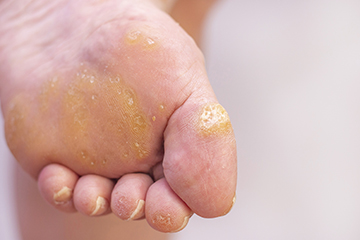
Corns vs Calluses
What Are Corns and Calluses?
Corns and Calluses are localized areas on the skin that have become thickened due to excessive pressure. It is a protective reaction that occurs whenever the skin is overloaded to the point that it might fail. When this situation occurs, the body will automatically begin thickening the skin to reinforce it. And though the end result may cause considerable discomfort, the alternative would be disastrous. Imagine if we did not have such a mechanism? Over time, we would ultimately wear a hole through our skin, exposing the muscles, tendons and bone...our life expectancy would be dramatically shorter. Fortunately, this process happens automatically and we are never aware of the situation until after the body has protected us!
How do Corns and Calluses form?
Whenever the local tissue is overloaded, the blood is squeezed out of the tissue. When the pressure is released, the blood rushes back in. If this process happens repeatedly, the local capillaries become dilated which results in an increase in blood to the local area. More blood means more food. More food means the faster the local skin will grow. The end result...a corn or callus will form. It is a simple mechanism, but highly effective at protecting our skin.
Are Corns and Calluses different?
Although they may share a resemblance and cause similar pain and discomfort, corns and calluses are slightly different. Here is a brief description of each to help you decipher what may be causing your foot discomfort.
Corns
Corns are hardened layers of skin that are a reaction from your feet to regular friction and pressure. A corn is a type of callus that will form when there is highly localised pressure, usually over a joint or bony prominence. It can sometimes appear yellowish in colour (for Caucasians) and darker brown to black (for darker coloured skin) . Corns usually appear small and circular, with a centre that is clearly defined and can be soft or hard to the touch depending on where it forms on the body.
Calluses
A callus forms over a much larger area and is less defined compared to a corn. It is essentially a section of skin that has become toughened and thick due to repeated friction, pressure, or irritation. Like corns, calluses may appear yellowish to dark brown/black, depending on the skin colour of the individual. Calluses on feet are extremely common and affect most adults.
Is it a Corn or Callus?
Both corns and calluses can cause pain and discomfort. Patients often describe the sensation as if you have a rock in your shoe when you’re walking. Corns and calluses are typically caused by:
- Wearing ill-fitting shoes
- Having very sweaty feet
- Wearing shoes without socks
- Standing for long periods of time in shoes that have insufficient cushioning and support.
There are some differences between a corn and callus that are worth noting:
- Corns tend to have a distinct, usually hard centre, which is surrounded by skin that is inflamed or irritated.
- Corns may be painful to the touch when pressed, as calluses are generally not painful.
- Corns are typically smaller than calluses and tend to be round and well-defined. Calluses on the other hand can vary in shape.
- Calluses will usually form on the soles of feet, especially under the heel or ball of your foot. Corns often appear on non-load bearing parts of your feet, like the top or sides of the toe.
How to Identify a Corn and a Callus
Do you have a corn or a callus? It's best to visit your chiropodist to confirm your foot condition and receive proper treatment. Here are some of the symptoms and signs that indicate it's time to schedule an appointment.
Symptoms related to corns:
- A hardened layer of skin on your foot that has a small, painful centre surrounded by inflamed skin.
- The area appears on the top, side or in between toes.
- The area is painful when touched.
Symptoms related to calluses:
- Calluses are not typically painful.
- The hardened layers of skin develop on the soles of your feet, especially the heel or ball of your foot.
- The hardened area is usually larger than a corn, although calluses do vary in size and shape.
Here's Why You Should Treat Corns and Calluses
Corns and calluses are not life-threatening, but there are some unique situations, particularly for diabetics, that can lead to infection, ulcerations and sadly, even amputations. A particular concern for a chiropodist when treating diabetics is encountering calluses that have trapped blood within them. In these situations, there is almost always an ulcer forming underneath the callus, and your window to prevent a complete breakdown in the skin is very small. If the pressure is not redistributed and the callus removed the patient will be faced with an ulcer in their foot. For this reason, it is so important to have a full foot health assessment, so that potential problems can be minimized.

